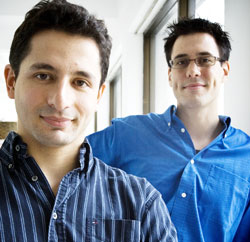Old habits... don’t die

Psychology grad students Giovanni Hernandez (left) and Michael Verwey both participated in the Student Data Blitz during the CSBN’s winter workshop. Hernandez is working with Peter Shizgal, while Verwey works with Shimon Amir.
andrew dobrowolskyj
As the saying goes, once you learn to ride a bike you’ll never forget how. Ann Graybiel wants to know why.
Graybiel is the Walter A. Rosenblith Professor of Neuroscience in the Department of Brain and Cognitive Science at the Massachusetts Institute of Technology. She is the acknowledged world leader in the study of the basal ganglia, and, according to one colleague, has “single-handedly transformed the study of this part of the brain.”
After more than 35 years in the field, she clearly still loves her job. While presenting her lab’s work to nearly 100 students and professors at Loyola last week, her description of the neurophysiology and neurochemistry of the basal ganglia was punctuated with exclamations like “so cool,” “awesome,” and “wildly interesting.”
Graybiel was the opening colloquium speaker for this year’s Winter Workshop held by the Concordia Center for Studies in Behavioral Neurobiology to celebrate Brain Week. Brain Week is an international effort to advance public awareness about the progress and benefits of brain research.
According to Michael Verwey, a PhD student working with Shimon Amir (Psychology and CSBN), “The workshops are an opportunity for researchers to talk critically and constructively about the work we are doing and the directions we consider important.”
Verwey and several other students from Concordia, McGill, Université de Montreal and University of Toronto presented their ongoing dissertation work in an early-morning Student Data Blitz. These workshops were followed by sessions led by professors from the same institutions.
The theme for this year’s workshops was “Dopaminergic modulation of motor and motivational functions of the striatum: Common principles?” In plain English, all the presentations focused on the basal ganglia and their role in getting us moving.
The basal ganglia are a group of deep forebrain structures. As Graybiel pointed out, “For a long time, they were primarily explored as centres of motor function because of their role in motor diseases such as Huntingdon’s and Parkinson’s.”
Higher functions such as thought, learning and emotional response were presumed to reside solely in the neocortex, a relatively new brain structure (in terms of evolution) found only in “higher” mammals like dolphins, chimpanzees, and, yes, humans.
Research at Graybiel’s lab, however, has turned those assumptions on their head. “We were all quite surprised when we began to think that the basal ganglia could be involved in cognitive function,” she said. But experimental work with rats, primates and humans has shown feedback loops between the basal ganglia and neocortex that become active during learning.
One application of the research is a clearer understanding of how we acquire habits.
Using rats, Graybiel and colleagues have determined that there is lots of activity in these loops while the animals learn a task. Once mastery has occurred, however, that activity drops off significantly except at key points in the task.
“It may be that the basal ganglia help us to mark particular behaviours,” she said, essentially breaking down and storing learned behaviours as discrete chunks of information. “When we are learning something, the brain does not know what is most important about the task. Once we’ve learned what’s most important, we can do the rest almost on auto-pilot.”
She provided driving as an example. “When you learn to drive you constantly think, gas, brake, gas, brake.” But when the task becomes habit, “You can drive familiar routes while completely engrossed in other thoughts.”
Graybiel’s research has also shown that once learning has become habit, it tends to persist. Most of the rats that learned the task could reproduce it after a short relearning phase, even after a relatively long period of time of not being exposed to it. This may explain why some habits are so hard to break.
“So, we’re really looking at questions of where patterns of behaviour are located in the brain, where they go when they are not being used, and how we manage to bring them back almost on command when they are required,” she summarized.
The answers may also help in understanding and treating diseases and disorders like Huntingdon’s, Parkinson’s, and Alzheimer’s, where habitual patterns break down, or like Tourette’s, OCD and drug abuse, where they become overwhelming.
While Graybiel clearly leads the collective work of her lab at MIT, she readily acknowledged contributions from the many graduate students, postdocs and collaborators from around the globe who are drawn there, including Concordia’s Richard Courte-manche (Exercise Science, CSBN). Courtmanche collaborated with Graybiel for his postdoctoral work.